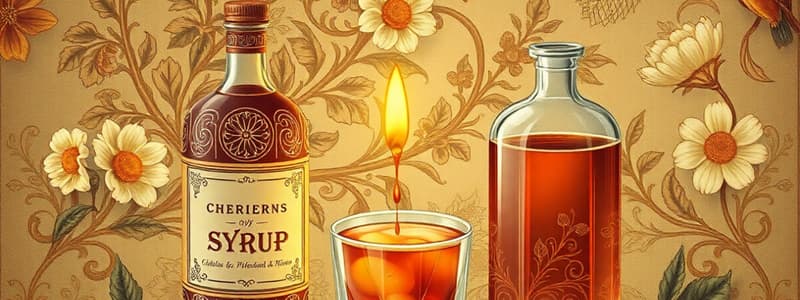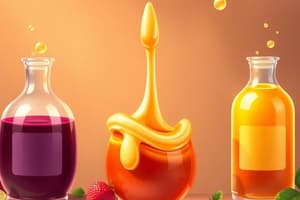Podcast
Questions and Answers
What is the main purpose of syrup of ipecac?
What is the main purpose of syrup of ipecac?
- To induce vomiting in cases of poisoning (correct)
- To reduce mucus production
- To relieve coughing
- To treat asthma
Which active ingredient in syrup of ipecac can lead to toxic buildup with continuous use?
Which active ingredient in syrup of ipecac can lead to toxic buildup with continuous use?
- Emetine (correct)
- Glycerin
- Bromhexine
- Salbutamol
What dosage of syrup of ipecac is commonly used for children?
What dosage of syrup of ipecac is commonly used for children?
- 20 mL
- 15 mL (correct)
- 10 mL
- 5 mL
Which of the following is NOT a consequence of misusing syrup of ipecac?
Which of the following is NOT a consequence of misusing syrup of ipecac?
What is the source plant for the active ingredients in ipecac syrup?
What is the source plant for the active ingredients in ipecac syrup?
What is the primary purpose of nonmedicated syrups?
What is the primary purpose of nonmedicated syrups?
Which syrup contains a suspension of cocoa powder?
Which syrup contains a suspension of cocoa powder?
What is a common use for medicated syrups?
What is a common use for medicated syrups?
What ingredient forms the base of simple syrup?
What ingredient forms the base of simple syrup?
Which of the following is a characteristic of medicated syrups?
Which of the following is a characteristic of medicated syrups?
Which syrup is known for containing the juice of cherries?
Which syrup is known for containing the juice of cherries?
Why might syrups be preferred for children or elderly patients when administering medication?
Why might syrups be preferred for children or elderly patients when administering medication?
What is the approximate volume percentage of raspberry juice in raspberry syrup?
What is the approximate volume percentage of raspberry juice in raspberry syrup?
What primary function does sucrose serve in syrups?
What primary function does sucrose serve in syrups?
Which component is NOT typically found in syrups?
Which component is NOT typically found in syrups?
What is the role of cellulose derivatives like methylcellulose in syrups?
What is the role of cellulose derivatives like methylcellulose in syrups?
What is the typical sucrose content range in most syrups?
What is the typical sucrose content range in most syrups?
Why are concentrated sugar solutions less prone to microbial growth than dilute sucrose solutions?
Why are concentrated sugar solutions less prone to microbial growth than dilute sucrose solutions?
What effect do antitussive syrups have besides delivering medication?
What effect do antitussive syrups have besides delivering medication?
Which of the following substances can be used as a sugar substitute in syrups?
Which of the following substances can be used as a sugar substitute in syrups?
What is one of the benefits of using non-glycogenetic substances in syrup formulations?
What is one of the benefits of using non-glycogenetic substances in syrup formulations?
What is the primary advantage of Syrup, NF being prepared with a slight excess of water?
What is the primary advantage of Syrup, NF being prepared with a slight excess of water?
Which ingredient is primarily responsible for the stability and resistance to microbial growth in Syrup, NF?
Which ingredient is primarily responsible for the stability and resistance to microbial growth in Syrup, NF?
How much sucrose is used to prepare 100 mL of Syrup, NF?
How much sucrose is used to prepare 100 mL of Syrup, NF?
What is the specific gravity of Syrup, NF?
What is the specific gravity of Syrup, NF?
What is the total weight of 100 mL of Syrup, NF?
What is the total weight of 100 mL of Syrup, NF?
Why must preservatives be added to some commercial syrups?
Why must preservatives be added to some commercial syrups?
What is required to dissolve 85 g of sucrose in water for Syrup, NF preparation?
What is required to dissolve 85 g of sucrose in water for Syrup, NF preparation?
What could happen if the syrup is overly saturated with sucrose during storage?
What could happen if the syrup is overly saturated with sucrose during storage?
What is the primary advantage of using boiled purified water in syrup preparation?
What is the primary advantage of using boiled purified water in syrup preparation?
Why is agitation without heat preferred for making syrup?
Why is agitation without heat preferred for making syrup?
What should be done to solid agents before adding them to a syrup?
What should be done to solid agents before adding them to a syrup?
What is a requirement for storing all types of syrups?
What is a requirement for storing all types of syrups?
When adding sucrose to a medicated liquid, what is correct regarding alcohol-soluble constituents?
When adding sucrose to a medicated liquid, what is correct regarding alcohol-soluble constituents?
What is the percolation method used for in syrup preparation?
What is the percolation method used for in syrup preparation?
What should be done if alcohol-soluble components in a tincture are undesirable in the syrup?
What should be done if alcohol-soluble components in a tincture are undesirable in the syrup?
Why is it more time-consuming to prepare syrup by agitation without heat than by using heat?
Why is it more time-consuming to prepare syrup by agitation without heat than by using heat?
Flashcards are hidden until you start studying
Study Notes
Syrup of Ipecac
- Purpose: To induce vomiting in cases of poisoning.
- Active ingredient: Emetine, which can lead to toxic buildup with continuous use.
- Dosage for children: 15 ml for children aged 1 to 12 years.
- Misuse consequence: Does NOT cause dehydration.
Syrups
- Source plant for ipecac syrup: Cephaelis ipecacuanha
- Nonmedicated syrups purpose: Primarily for flavoring and masking unpleasant tastes.
- Cocoa powder syrup: Chocolate syrup
- Medicated syrups purpose: To administer medication, especially for children and elderly patients.
- Simple syrup base: Sugar (usually sucrose)
- Medicated syrup characteristics: Contains a sweetening agent and a drug.
- Cherry syrup: Cherry syrup
- Why preferred for children/elderly: Easier to swallow and masks unpleasant tastes.
- Raspberry syrup: Approximately 30% raspberry juice.
- Sucrose function: Sweetening, viscosity, and preservation.
- Non-syrup component: Fats
- Cellulose derivative role: Adds viscosity, stability, and prevents crystallization.
- Sucrose content: Usually 60-80% by weight.
- Concentrated sugar resistant to microbial growth: Higher sugar concentration makes water less available for microbial growth.
- Antitussive syrup effect: Besides delivering medication, they soothe the throat and suppress coughing.
- Sugar substitute for syrups: Sorbitol
- Benefit of non-glycogenetic substances: They don't contribute to blood sugar levels.
- Excess water in Syrup, NF: Ensures complete dissolution of sucrose and prevents crystallization.
- Syrup, NF stability: Sucrose is the main contributor to its stability and resistance to microbial growth.
- Sucrose in 100 mL Syrup, NF: 85 grams
- Syrup, NF specific gravity: 1.313
- Syrup, NF total weight in 100 mL: 131.3g
- Preservatives in commercial syrups: To prevent microbial growth during storage.
- Dissolving 85g sucrose: Add sufficient purified water to dissolve the sucrose.
- Overly saturated syrup: May lead to crystallization during storage.
- Boiled purified water advantage: Ensures sterility and prevents microbial contamination.
- Agitation without heat: Preferred to avoid caramelization of sugar.
- Solid agents in syrup: Must be finely powdered and gradually added to the syrup.
- Syrup storage: In tightly closed containers to prevent evaporation and contamination.
- Alcohol-soluble constituents in medicated liquid: They're unaffected by the addition of sucrose.
- Percolation method: Used to extract active compounds from herbs or other materials.
- Undesirable alcohol-soluble components: Use a different extraction method or remove the components before adding sucrose.
- Agitation without heat: Time consuming: Takes longer than using heat because the dissolution process is slower.
Studying That Suits You
Use AI to generate personalized quizzes and flashcards to suit your learning preferences.




